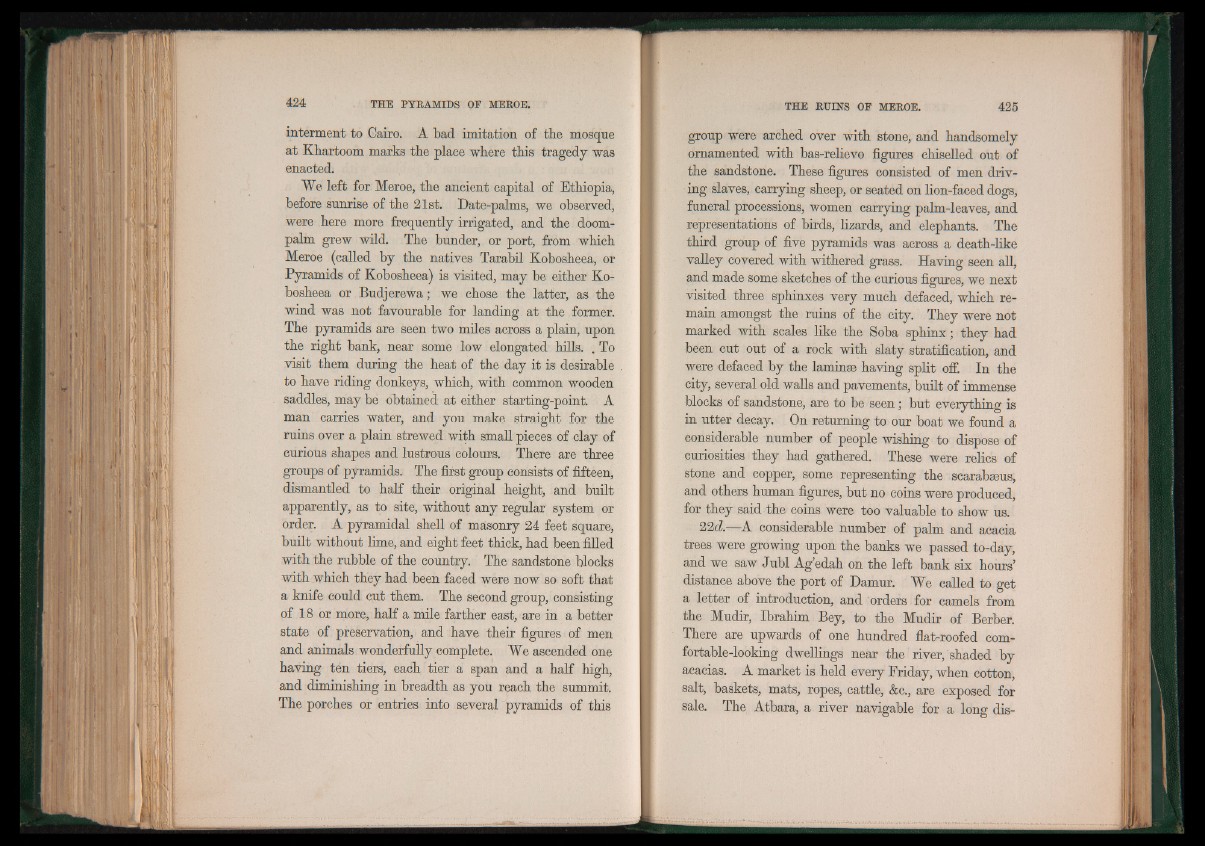
interment to Cairo. A bad imitation of the mosque
at Khartoom marks the place where this tragedy was
enacted.
We left for Meroe, the ancient capital of Ethiopia,
before sunrise of the 21st. Date-palms, we observed,
were here more frequently irrigated, and the doom-
palm grew wild. The bunder, or port, from which
Meroe (called by the natives Tarabil Kobosheea, or
Pyramids of Kobosheea) is visited, may be either Kobosheea
or Budjerewa; we chose the latter, as the
wind was not favourable for landing at the former.
The pyramids are seen two miles across a plain, upon
the right bank, near some low elongated hills. . To
visit them during the heat of the day it is desirable
to have riding donkeys, which, with common wooden
saddles, may be obtained at either starting-point. A
man carries water, and you make straight for the
ruins over a plain strewed with small pieces of clay of
curious shapes and lustrous colours. There are three
groups of pyramids. The first group consists of fifteen,
dismantled to half their original height, and built
apparently, as to site, without any regular system or
order. A pyramidal shell of masonry 24 feet square,
built without lime, and eight feet thick, had been filled
with the rubble of the country. The sandstone blocks
with which they had been faced were now so soft that
a knife could cut them. The second group, consisting
of 18 or more, half a mile farther east, are in a better
state of preservation, and have their figures of men
and animals wonderfully complete. We ascended one
having ten tiers, each tier a span and a half high,
and diminishing in breadth as you reach the summit.
The porches or entries into several pyramids of this
group were arched over with stone, and handsomely
ornamented with bas-relievo figures chiselled out of
the sandstone. These figures consisted of men driving
slaves, carrying sheep, or seated on lion-faced dogs,
funeral processions, women carrying palm-leaves, and
representations of birds, lizards, and elephants. The
third group of five pyramids was across a death-like
valley covered with withered grass. Having seen all,
and made some sketches of the curious figures, we next
visited three sphinxes very much defaced, which remain
amongst the ruins of the city. They were not
marked with scales like the Soba sphinx; they had
been cut out of a rock with slaty stratification, and
were defaced by the laminae having split off. In the
city, several old walls and pavements, built of immense
blocks of sandstone, are to be seen; but everything is
in utter decay. On returning to our boat we found a
considerable number of people wishing to dispose of
curiosities they had gathered. These were relics of
stone and copper, some representing the scarabseus,
and others human figures, but no coins were produced,
for they said the coins were too valuable to show us.
22d—A considerable number of palm and acacia
trees were growing upon the banks we passed to-day,
and we saw Jubl Ag’edah on the left bank six hours’
distance above the port of Damur. We called to get
a letter of introduction, and orders for camels from
the Mudir, Ibrahim Bey, to the Mudir of Berber.
There are upwards of one hundred flat-roofed comfortable
looking dwellings near the river, shaded by
acacias. A market is held every Friday, when cotton,
salt, baskets, mats, ropes, cattle, &c., are exposed for
sale. The Atbara, a river navigable for a long dis